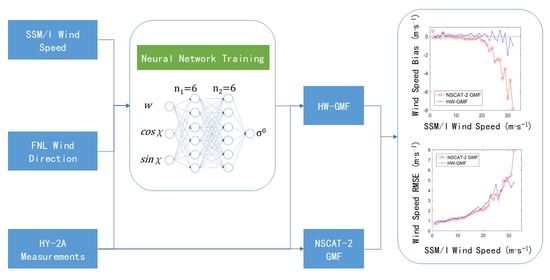High Wind Geophysical Model Function Modeling for the HY-2A Scatterometer Using Neural Network
Abstract
:1. Introduction
- (1)
- Declined sensitivity in backscatter
- (2)
- Rain effect
- (3)
- Scarcity of observations
2. Data and Methods
2.1. DataSet
2.1.1. HY-2A Scatterometer Data
2.1.2. SSM/I Wind Field Data
2.1.3. FNL Data
2.1.4. TAO Data
2.1.5. NII Typhoon Data
2.2. Data Validation
2.3. Methods
2.3.1. Geophysical Model Function
2.3.2. BP Neural Network Modeling
2.3.3. Wind Vector Retrieval
- (1)
- Take the wind direction as 0 degrees, give a starting wind speed (such as 7 m/s), find the wind speed that makes the objective function obtain the maximum value according to the wind speed interval, and record the wind speed and the corresponding objective function value.
- (2)
- Increment wind direction, take the wind speed determined at previous wind direction as the starting wind speed, determine and record the wind speed and associated objective function value for the current wind direction.
- (3)
- Move to the next wind direction, repeat step (2) until all the wind speeds and objective function values are found for every wind direction within the range between 0° and 360°.
- (4)
- Search and rank the local maxima of Equation (12) along wind direction. Record the local maxima and their corresponding wind speeds and wind directions as wind vector ambiguities.
3. Results
3.1. Comparison of GMFs
3.2. Model Backscattering Coefficient Verification
3.3. Validation of Retrieved Wind Vectors
4. Discussion
5. Conclusions
Author Contributions
Funding
Data Availability Statement
Acknowledgments
Conflicts of Interest
References
- Liu, W.T. Progress in scatterometer application. J. Oceanogr. 2002, 58, 121–136. [Google Scholar] [CrossRef]
- Dickinson, S.; Kelly, K.; Caruso, M.; McPhaden, M. Comparisons between the TAO buoy and NASA scatterometer wind vectors. J. Atmos. Ocean. Technol. 2001, 18, 799–806. [Google Scholar] [CrossRef]
- Schroeder, L.; Boggs, D.; Dome, G.; Halberstam, I.; Jones, W.; Pierson, W.; Wentz, F. The relationship between wind vector and normalized radar cross section used to derive SEASAT-A satellite scatterometer winds. J. Geophys. Res. 1982, 87, 313–336. [Google Scholar] [CrossRef]
- Brown, R.; Cardone, V.; Guymer, T.; Hawkins, J.; Overland, J.; Pierson, W.; Peteherych, S.; Wilkerson, J.; Woiceshyn, P.; Wurtele, M. Surface wind analyses for SEASAT. J. Geophys. Res. 1982, 87, 3355–3364. [Google Scholar] [CrossRef]
- Quilfen, Y.; Bentamy, A. Calibration/validation of ERS-1 scatterometer precision products. In Proceedings of the 1994 IEEE International Geoscience and Remote Sensing Symposium, Pasadena, CA, USA, 8–12 August 1994. [Google Scholar]
- Portabella, M. Wind Field Retrieval from Satellite Radar Systems. Ph.D. Thesis, University of Barcelona, Barcelona, Spain, 2002. [Google Scholar]
- Kloe, J.; Stoffelen, A.; Verhoef, A. Improved use of scatterometer measurements by using stress-equivalent reference winds. IEEE J.-Stars. 2017, 10, 2340–2347. [Google Scholar] [CrossRef]
- Ricciardulli, L.; Wentz, F.J. A scatterometer geophysical model function for climate-quality winds: QuikSCAT Ku-2011. J. Atmos. Ocean. Technol. 2015, 32, 1829–1846. [Google Scholar] [CrossRef]
- Soisuvarn, S.; Jelenak, Z.; Chang, P.S.; Alsweiss, S.O.; Zhu, Q. CMOD5.H—A high wind geophysical model function for c-band vertically polarized satellite scatterometer measurements. IEEE Trans. Geosci. Remote Sens. 2013, 51, 3744–3760. [Google Scholar] [CrossRef]
- Wentz, F.J.; Smith, D.K. A model function for the ocean-normalized radar cross section at 14 GHz derived from NSCAT observations. J. Geophys. Res. 1999, 104, 11499–11514. [Google Scholar] [CrossRef]
- Stoffelen, A.; Verspeek, J.; Vogelzang, J.; Verhoef, A. The CMOD7 geophysical model function for ASCAT and ERS wind retrievals. IEEE J.-Stars. 2017, 10, 2123–2134. [Google Scholar] [CrossRef]
- Wang, Z.; Stoffelen, A.; Zhao, C.; Vogelzang, J.; Verhoef, A.; Verspeek, J.; Lin, M.; Chen, G. An SST-dependent ku-band geophysical model function for RapidScat. J. Geophys. Res. Ocean. 2017, 122, 3461–3480. [Google Scholar] [CrossRef]
- Lin, W.; Portabella, M.; Stoffelen, A.; Verhoef, A.; Wang, Z. Validation of the NSCAT-5 geophysical model function for Scatsat-1 wind scatterometer. In Proceedings of the 2018 IEEE International Geoscience and Remote Sensing Symposium, Valencia, Spain, 22–27 July 2018. [Google Scholar]
- Carswell, J.; Carson, S.; McIntosh, R.; Li, F.; Neumann, G.; McLaughlin, D.; Wilkerson, J.; Black, P.; Nghiem, S.V. Airborne scatterometers: Investigating ocean backscatter under low- and high- wind conditions. Proc. IEEE 1995, 82, 1835–1860. [Google Scholar] [CrossRef]
- Donnelly, W.; Carswell, J.; McIntosh, R.; Chang, P.; Wilkerson, J. Revised ocean backscatter models at C and Ku band under high-wind conditions. J. Geophys. Res. 1999, 104, 11411–11498. [Google Scholar] [CrossRef]
- Zeng, L.; Brown, R.A. Scatterometer observations at high wind speeds. J. Appl. Meteorol. 1998, 37, 1412–1420. [Google Scholar] [CrossRef]
- Zec, J.; Jones, W.L. Tropical cyclone geophysical model function for ocean surface wind retrievals from NASA scatterometer measurements at high wind speeds. In Proceedings of the 1999 IEEE International Geoscience and Remote Sensing Symposium, Hamburg, Germany, 28 June–2 July 1999. [Google Scholar]
- Yueh, S.H.; Stiles, B.W.; Bryan, W.; Tsai, W.Y.; Hu, H.; Liu, W.T. QuikSCAT geophysical model function for tropical cyclones and application to hurricane Floyd. IEEE Trans. Geosci. Remote Sens. 2001, 39, 2601–2612. [Google Scholar] [CrossRef]
- Yueh, S.H.; Stiles, B.W.; Liu, W.T. QuikSCAT wind retrievals for tropical cyclones. IEEE Trans. Geosci. Remote Sens. 2003, 41, 2616–2628. [Google Scholar] [CrossRef] [Green Version]
- Zou, J.; Xie, X.; Zhang, Y.; Lin, M. Wind retrieval processing for HY-2A microwave scatterometer. In Proceedings of the 2014 IEEE International Geoscience and Remote Sensing Symposium, Quebec City, QC, Canada, 13–18 July 2014. [Google Scholar]
- Mu, B.; Song, Q. In-orbit radiometric calibration of the HY-2A microwave scatterometer through open ocean measurements. J. Remote Sens. 2014, 18, 1072–1086. [Google Scholar]
- Peng, H.; Mu, B.; Lin, M.; Zhou, W. HY-2A satellite calibration and validation approach and results. In Proceedings of the 2014 IEEE International Geoscience and Remote Sensing Symposium, Quebec City, QC, Canada, 13–18 July 2014. [Google Scholar]
- Wang, D.; Yao, X.; Zhang, W. Validation and analysis of wind field products of HY-2. Mar. Forecast. 2014, 31, 47–53. [Google Scholar]
- Xing, J.; Shi, J.; Lei, Y.; Huang, X.; Liu, Z. Using data from buoys, ERA-Interim and ASCAT during 2012–2014. Remote Sens. 2016, 8, 390. [Google Scholar] [CrossRef] [Green Version]
- Wang, H.; Zhu, J.; Lin, M.; Huang, X.; Zhao, Y.; Chen, C. First six months quality assessment of HY-2A SCAT wind products using in situ measurements. Acta. Oceanol. Sin. 2013, 32, 27–33. [Google Scholar] [CrossRef]
- Wu, Q.; Chen, G. Validation and intercomparison of HY-2A/MetOp-A/Oceansat-2 scatterometer wind products. Chin. J. Oceanol. Limnol. 2015, 33, 1181–1190. [Google Scholar] [CrossRef]
- Yang, X.; Liu, G.; Li, Z.; Yu, Y. Preliminary validation of ocean surface vector winds estimated from China’s HY-2A scatterometer. Int. J. Remote Sens. 2014, 35, 4532–4543. [Google Scholar] [CrossRef]
- Zheng, M.; Li, X.; Sha, J. Comparison of sea surface wind field measured by HY-2A scatterometer and WindSat in global oceans. J. Oceanol. Limnol. 2019, 37, 38–46. [Google Scholar] [CrossRef]
- Xu, X.; Dong, X.; Zhu, D.; Lang, S. High winds from combined active and passive measurements of HY-2A satellite. IEEE J. Sel. Top. Appl. Earth Obs. Remote Sens. 2018, 11, 4339–4348. [Google Scholar] [CrossRef]
- Xie, X.; Wang, J.; Lin, M. A neural network-based rain effect correction method for HY-2A scatterometer backscatter measurements. Remote Sens. 2020, 12, 1648. [Google Scholar] [CrossRef]
- Zhang, Y.; Mu, B.; Lin, M.; Song, Q. An evaluation of the Chinese HY-2B satellite’s microwave scatterometer instrument. IEEE Trans. Geosci. Remote Sens. 2021, 59, 4513–4521. [Google Scholar] [CrossRef]
- Wang, Z.; Zou, J.; Stoffelen, A.; Lin, W.; Li, X.; He, Y.; Zhang, Y.; Lin, M. Scatterometer sea surface wind product validation for HY-2C. IEEE J. Sel. Top. Appl. Earth Obs. Remote Sens. 2021, 14, 6156–6163. [Google Scholar] [CrossRef]
- Meissner, T.; Wentz, F.J. The Emissivity of the Ocean Surface between 6 and 90 GHz over a Large Range of Wind Speeds and Earth Incidence Angles. IEEE Trans. Geosci. Remote Sens. 2012, 50, 3004–3026. [Google Scholar] [CrossRef]
- Thomas, B.R.; Kent, E.C.; Swail, V.R. Methods to homogenize wind speeds from ships and buoys. Int. J. Climatol. 2005, 25, 979–995. [Google Scholar] [CrossRef]
- Xie, X.; Huang, Z.; Lin, M.; Chen, K.; Lan, Y.; Yuan, X.; Ye, X.; Zhou, J. A novel integrated algorithm for wind vector retrieval from conically scanning scatterometers. Remote Sens. 2013, 15, 6180–6197. [Google Scholar] [CrossRef] [Green Version]
- Fang, P.; Zhao, B.; Zeng, Z.; Yu, H.; Lei, X.; Tan, J. Effects of wind direction on variations in friction velocity with wind speed under conditions of strong onshore wind. J. Geophys. Res. Atmos. 2018, 123, 7340–7353. [Google Scholar] [CrossRef]
- Andreas, E.L.; Mahrt, L.; Vickers, D. A new drag relation for aerodynamically rough flow over the ocean. J. Atmos. Sci. 2012, 69, 2520–2537. [Google Scholar] [CrossRef]
- Bozzano, R.; Siccardi, A.; Schiano, E.; Borghini, M.; Castellari, S. Comparison of ECMWF surface meteorology and buoy observations in the Ligurian Sea. Ann. Geophys. 2004, 22, 317–330. [Google Scholar] [CrossRef] [Green Version]
- Wentz, F.J. A well-calibrated ocean algorithm for Special Sensor Microwave/Imager. J. Geophys. Res. 1997, 22, 8703–8718. [Google Scholar] [CrossRef] [Green Version]
- Wentz, F.J. SSM/I Version-7 Calibration Report; Technical Report No. 011012; Remote Sensing Systems Corporation: Santa Rosa, CA, USA, 2013. [Google Scholar]
- Digital Typhoon: Typhoon Images and Information. Available online: http://agora.ex.nii.ac.jp/digital-typhoon/index.html.en (accessed on 18 June 2020).
- Hurricane Forecast and Preparedness. Available online: https://www.aoml.noaa.gov/hrd-faq/#forecast-accuracy (accessed on 30 May 2020).
- Freilich, M.H. SeaWinds Algorithm Theoretical Basis Document. Available online: http://podaac.jpl.nasa.gov/quikscat/qscat-doc/html (accessed on 18 March 2002).
- Brown, R. On Satellite Scatterometer Model functions. J. Geophys. Res. 2000, 105, 29195–29205. [Google Scholar] [CrossRef] [Green Version]
- Lin, W.; Portabella, M. Toward an Improved Wind Quality Control for RapidScat. IEEE Trans. Geosci. Remote Sens. 2017, 55, 3922–3930. [Google Scholar] [CrossRef] [Green Version]
- Portabella, M.; Stoffelen, A. A probabilistic approach for SeaWinds data assimilation. Q. J. Roy. Meteor. Soc. 2004, 130, 127–152. [Google Scholar] [CrossRef] [Green Version]
- Howard, S. A circular median filter approach for resolving directional ambiguities in wind fields retrieved from spaceborne scatterometer data. J. Geophys. Res. Ocean. 1990, 95, 5291–5303. [Google Scholar]
- Carswell, J.; Knapp, E.; Chang, P. Limitations of scatterometry high wind speed retrieval. In Proceedings of the 2000 IEEE International Geoscience and Remote Sensing Symposium, Honolulu, HI, USA, 24–28 July 2000. [Google Scholar]
- Fois, F.; Hoogeboom, P.; Chevalier, F.; Stoffelen, A. Future ocean scatterometry: On the use of cross-polar scattering to observe very high winds. IEEE Trans. Geosci. Remote Sens. 2015, 53, 5009–5020. [Google Scholar] [CrossRef]
- Yin, X.; Wang, Z.; Song, Q.; Huang, Y.; Zhang, R. Estimation of ocean wind vectors inside tropical cyclones from polarimetric radiometer. IEEE J. Sel. Top. Appl. Earth Obs. Remote Sens. 2017, 10, 1701–1714. [Google Scholar] [CrossRef]
- Kumar, P.; Gairola, R. Fostering the need of L-band radiometer extreme oceanic wind research. IEEE Trans. Geosci. Remote Sens. 2022, 60, 4103906. [Google Scholar] [CrossRef]
- NSCAT-4 Geophysical Model Function. Available online: https://scatterometer.knmi.nl/nscat4_gmf/ (accessed on 15 August 2020).
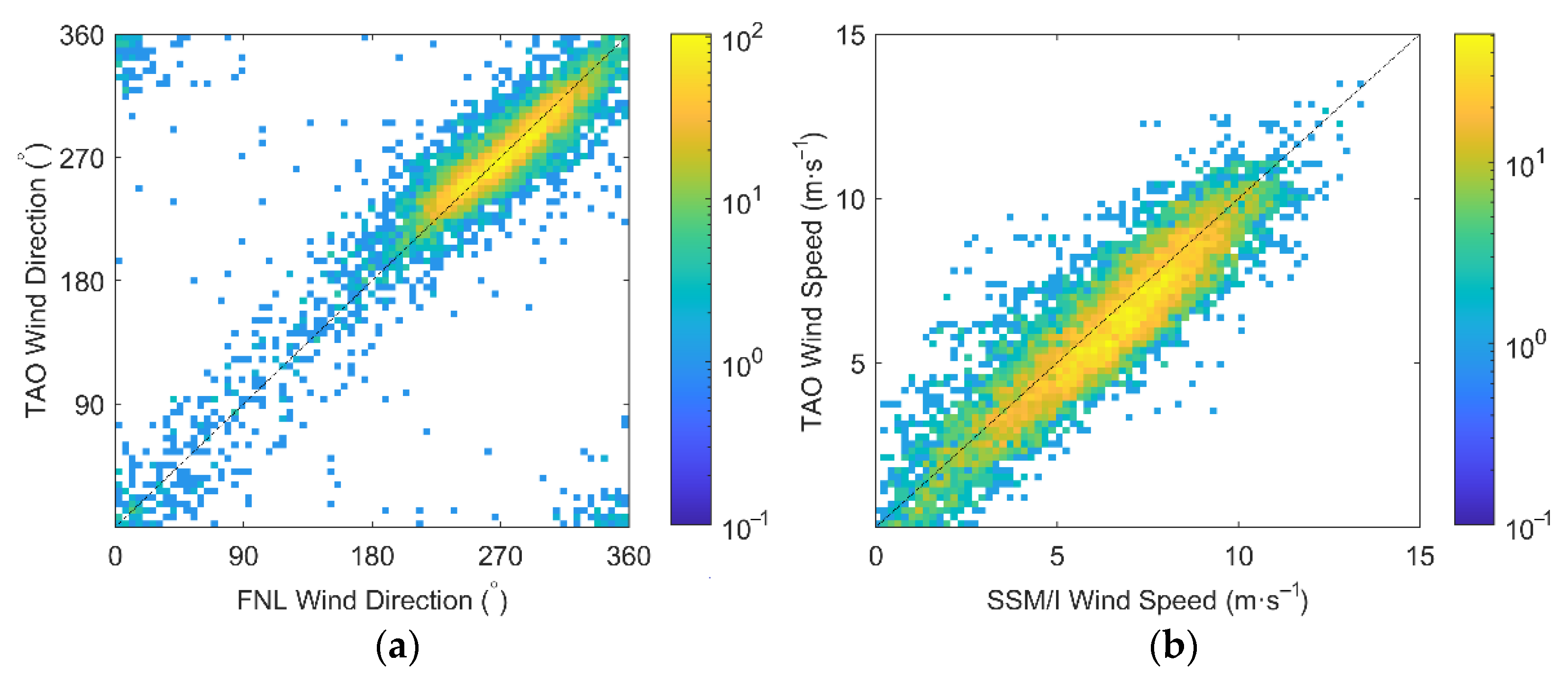

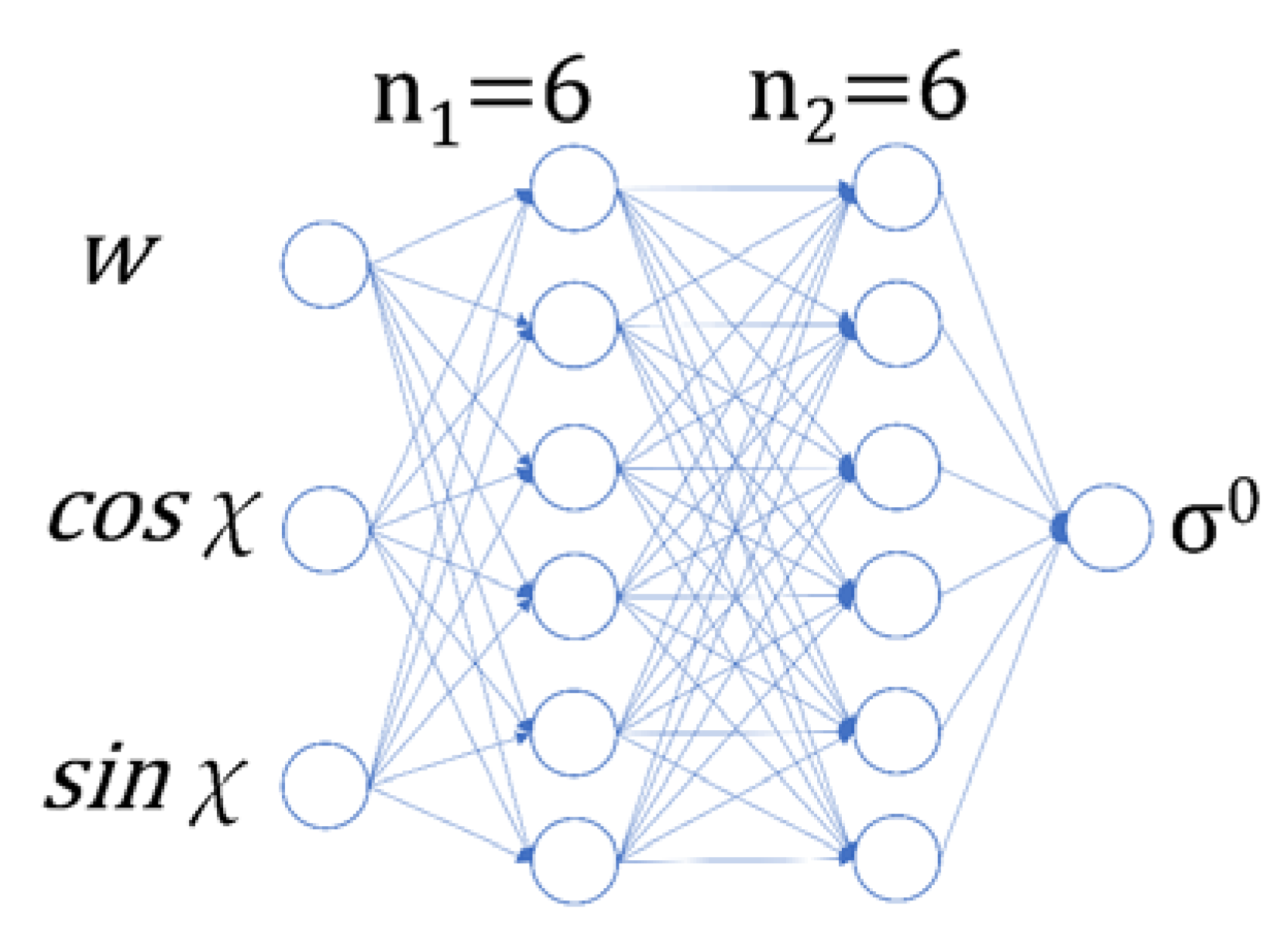
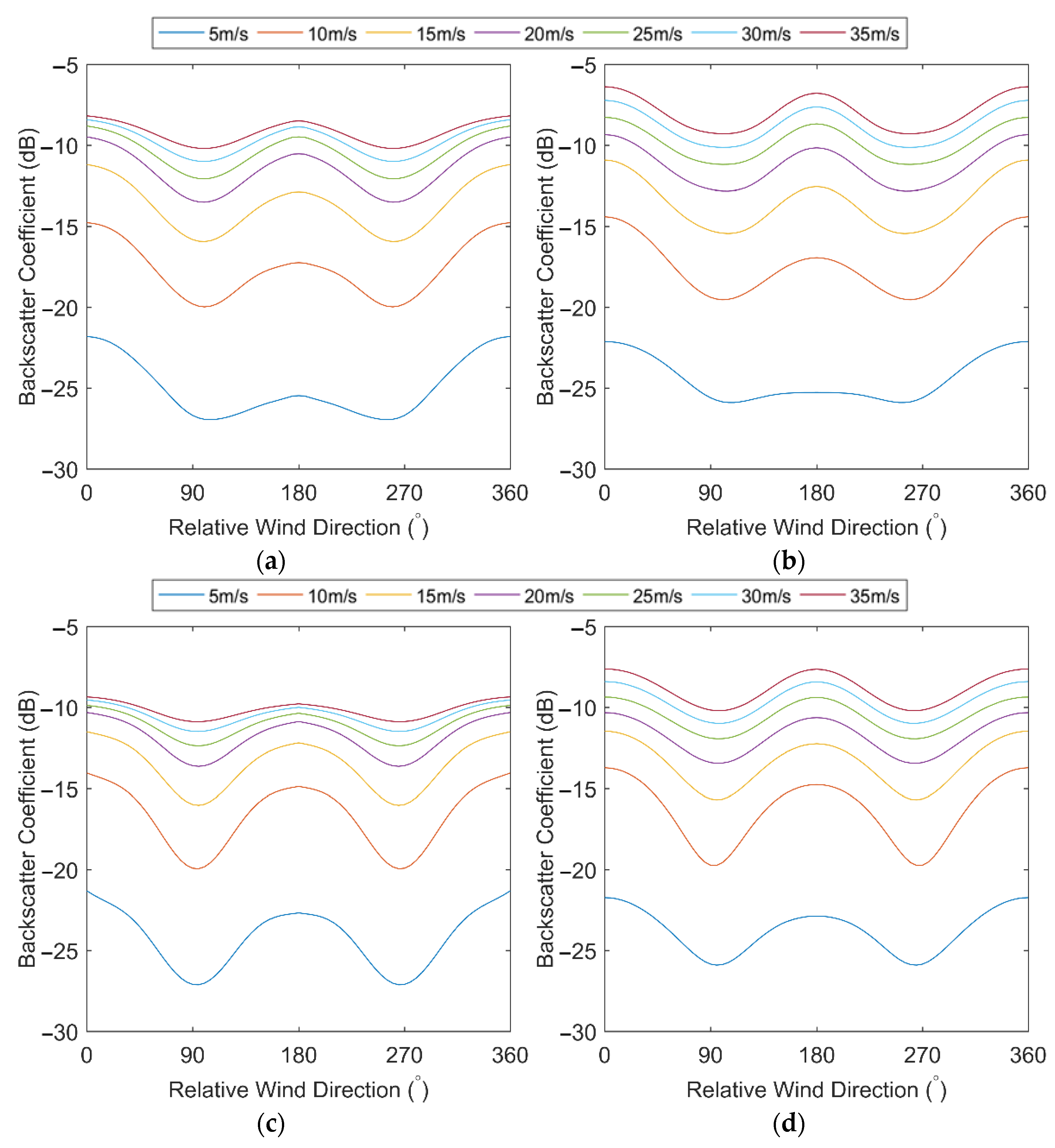

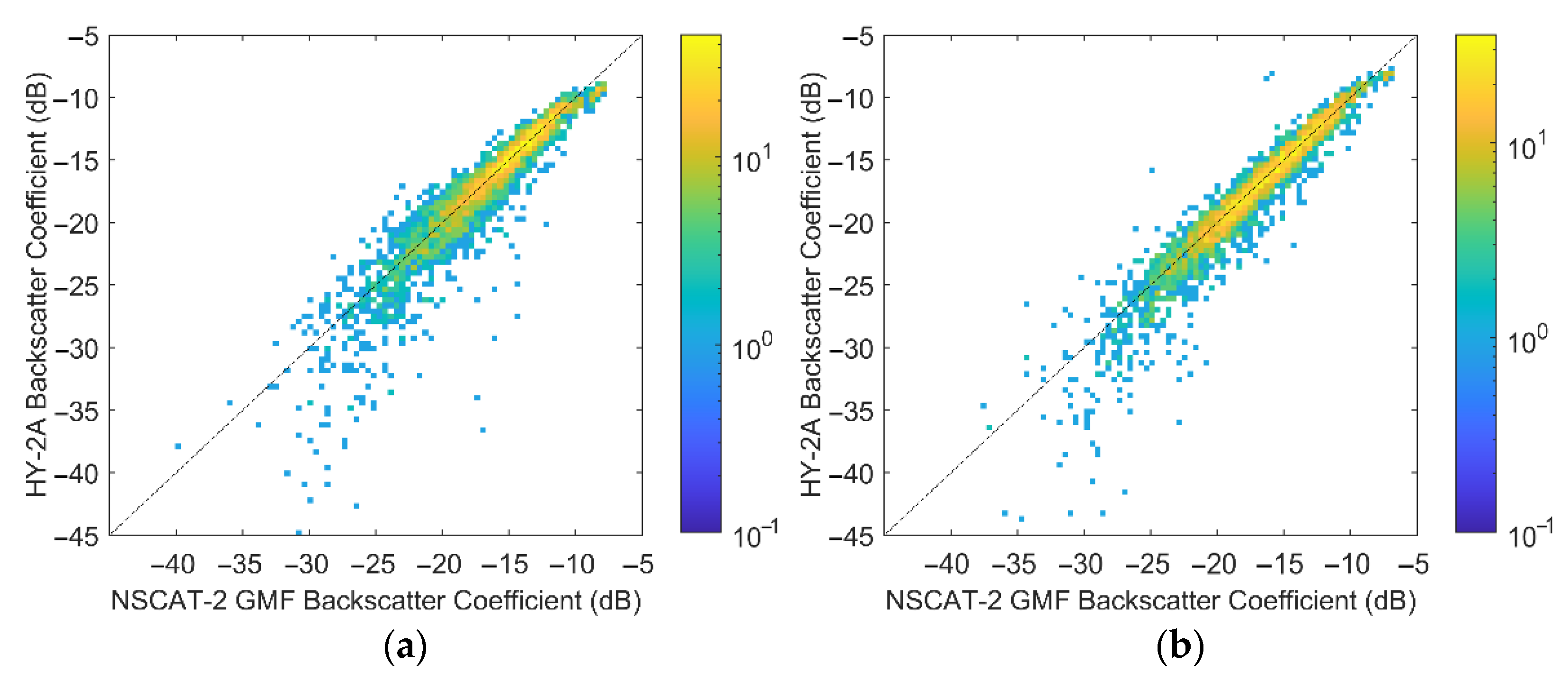

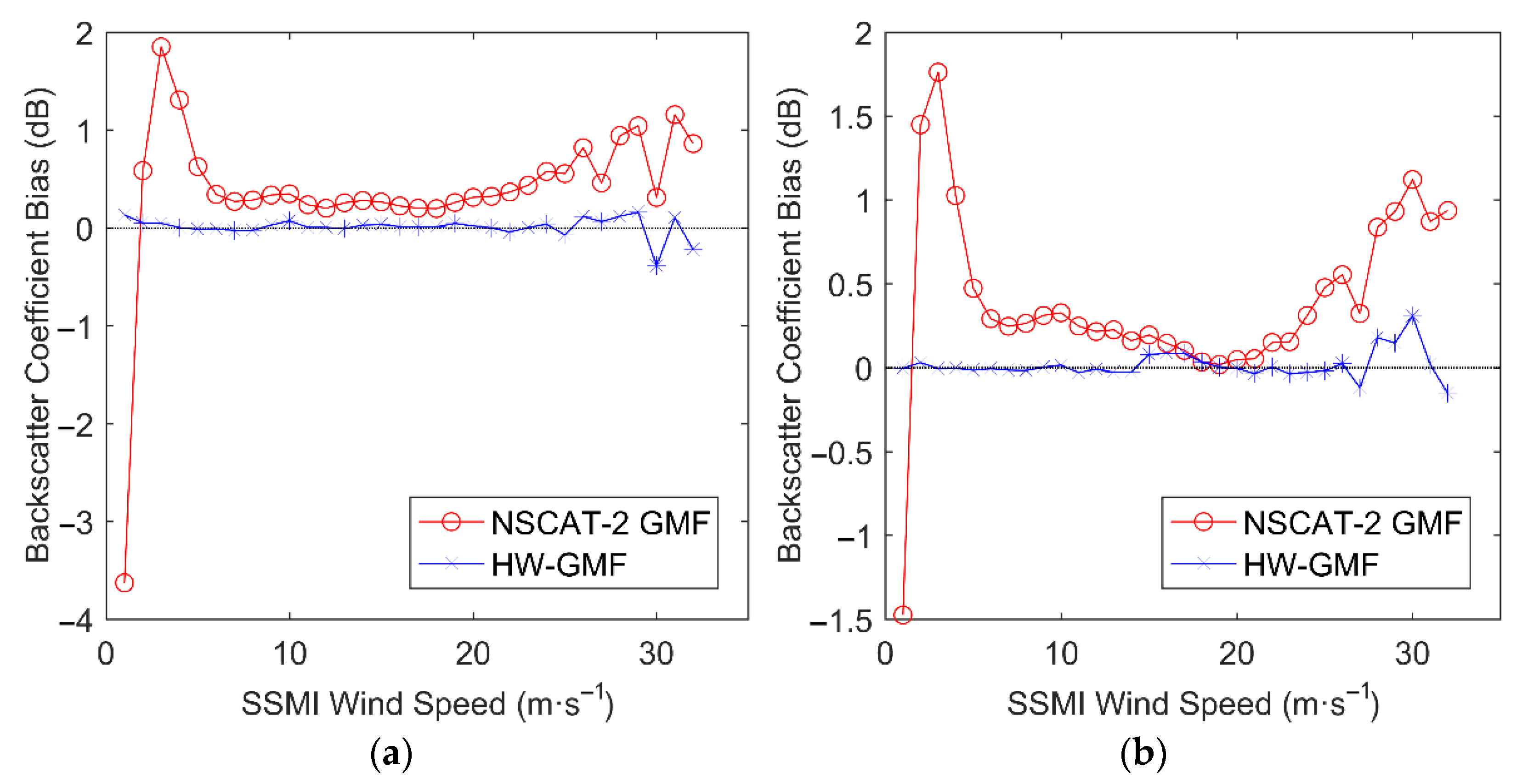
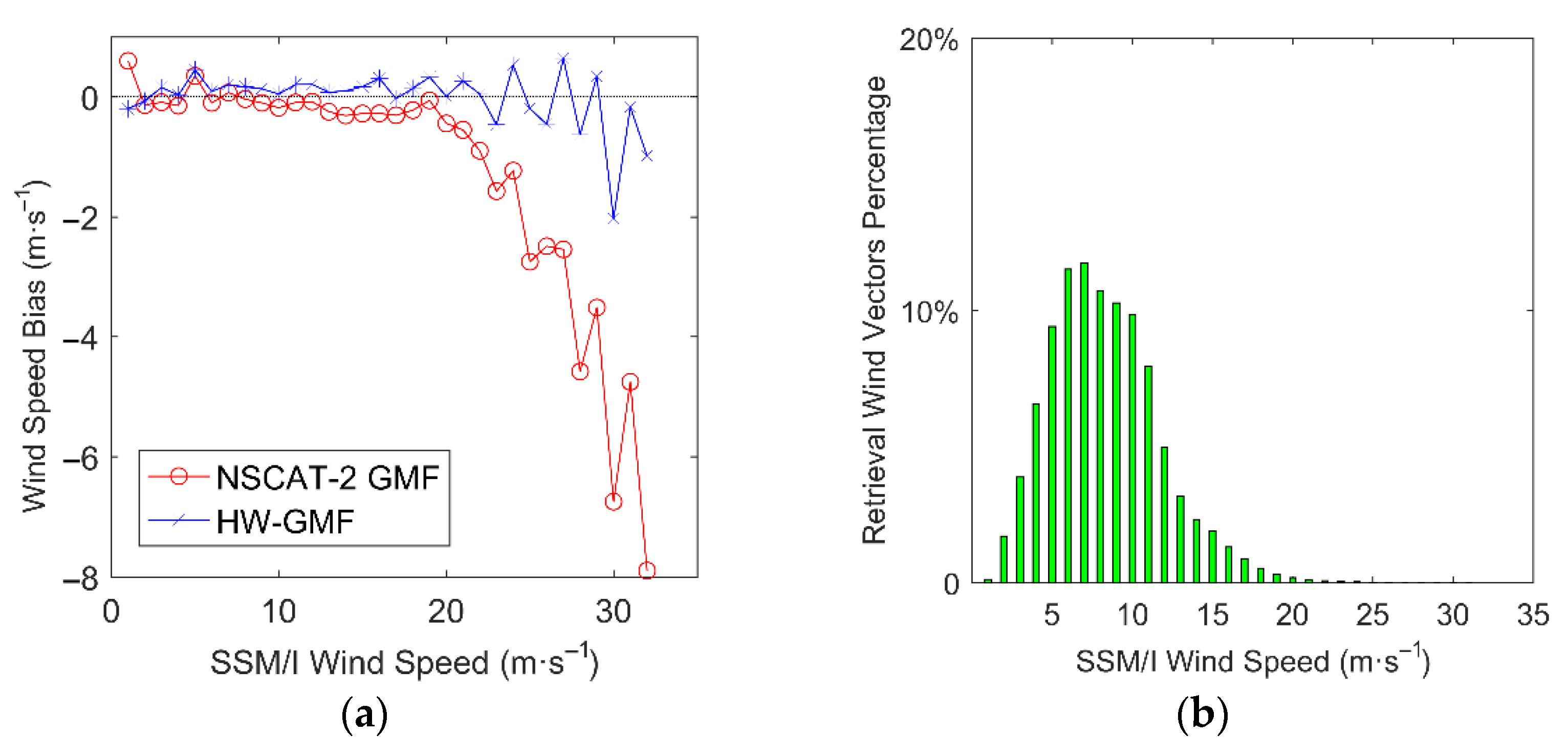


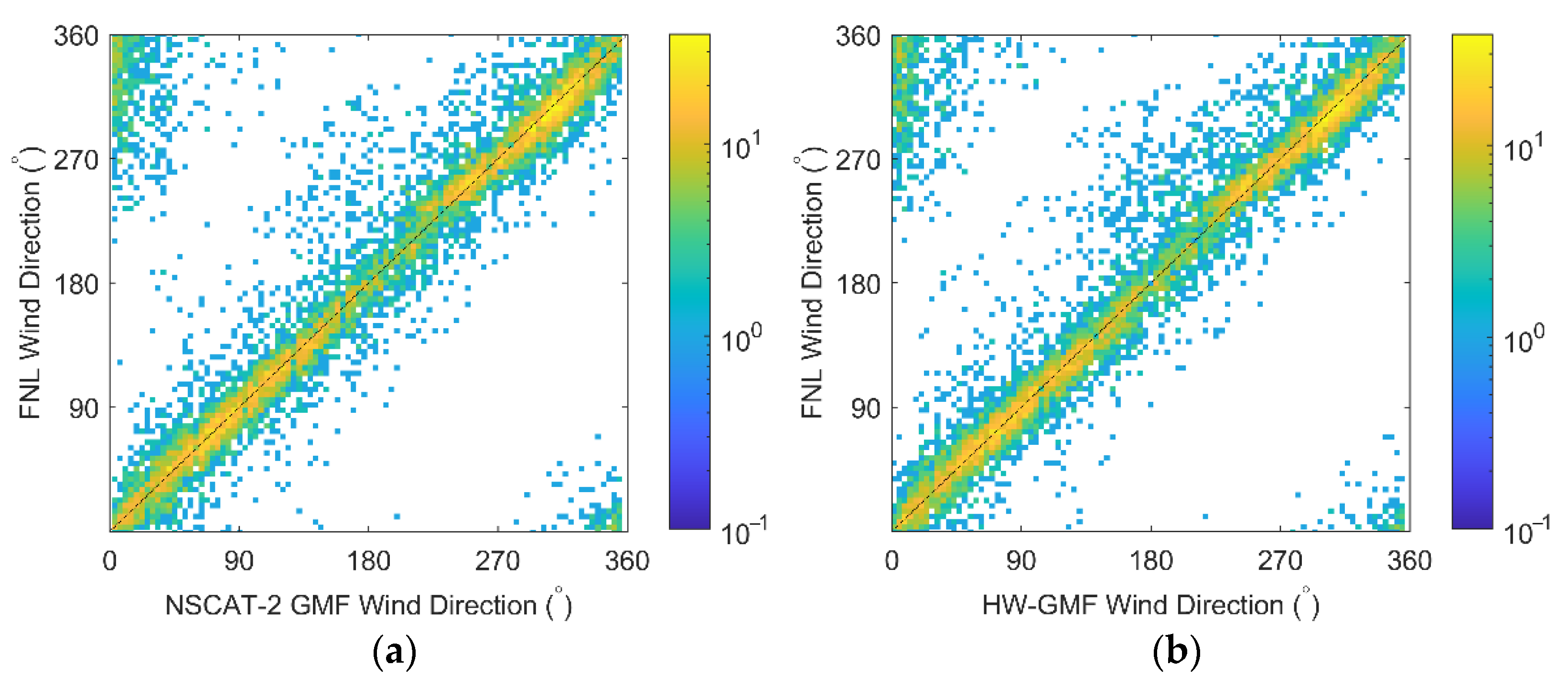
| Bias | Standard Deviation | |
|---|---|---|
| FNL wind direction (°) | −0.3634 | 14.4150 |
| SSM/I wind speed (m/s) | −0.2579 | 0.9554 |
| Bias | Standard Deviation | |
|---|---|---|
| SSM/I Wind Speed (m/s) | 0.5402 | 2.2347 |
| NII Wind Speed (m/s) | 0.6758 | 4.3049 |
| 0° | 5° | 10° | 15° | 20° | 25° | 30° | 35° | 40° | 45° | 50° | 55° | 60° | 65° | 70° | 75° | 80° | 85° | 90° | 95° | 100° | 105° | 110° | 115° | 120° | 125° | 130° | 135° | 140° | 145° | 150° | 155° | 160° | 165° | 170° | 175° | 180° | |
|---|---|---|---|---|---|---|---|---|---|---|---|---|---|---|---|---|---|---|---|---|---|---|---|---|---|---|---|---|---|---|---|---|---|---|---|---|---|
| 1 m/s | −35.4675 | −35.5341 | −35.6079 | −35.6889 | −35.7765 | −35.8702 | −35.9695 | −36.0739 | −36.1831 | −36.2971 | −36.4161 | −36.5398 | −36.6668 | −36.7945 | −36.9186 | −37.0340 | −37.1357 | −37.2193 | −37.2822 | −37.3233 | −37.3433 | −37.3445 | −37.3305 | −37.3061 | −37.2763 | −37.2455 | −37.2167 | −37.1911 | −37.1683 | −37.1470 | −37.1259 | −37.1035 | −37.0788 | −37.0510 | −37.0195 | −36.9839 | −36.9440 |
| 2 m/s | −32.9884 | −33.0973 | −33.2198 | −33.3553 | −33.5031 | −33.6621 | −33.8312 | −34.0096 | −34.1965 | −34.3916 | −34.5945 | −34.8042 | −35.0181 | −35.2314 | −35.4377 | −35.6295 | −35.8003 | −35.9446 | −36.0596 | −36.1442 | −36.1992 | −36.2273 | −36.2328 | −36.2215 | −36.1999 | −36.1739 | −36.1479 | −36.1237 | −36.1012 | −36.0790 | −36.0549 | −36.0270 | −35.9940 | −35.9546 | −35.9081 | −35.8539 | −35.7914 |
| 3 m/s | −28.6308 | −28.7200 | −28.8434 | −29.0041 | −29.2026 | −29.4369 | −29.7019 | −29.9911 | −30.2976 | −30.6165 | −30.9465 | −31.2900 | −31.6501 | −32.0240 | −32.3974 | −32.7462 | −33.0460 | −33.2822 | −33.4540 | −33.5709 | −33.6477 | −33.7003 | −33.7426 | −33.7841 | −33.8280 | −33.8708 | −33.9024 | −33.9100 | −33.8843 | −33.8251 | −33.7432 | −33.6541 | −33.5701 | −33.4958 | −33.4315 | −33.3767 | −33.3327 |
| 4 m/s | −24.7055 | −24.7655 | −24.8610 | −24.9977 | −25.1782 | −25.4026 | −25.6675 | −25.9670 | −26.2937 | −26.6411 | −27.0048 | −27.3843 | −27.7810 | −28.1940 | −28.6134 | −29.0189 | −29.3845 | −29.6888 | −29.9221 | −30.0864 | −30.1923 | −30.2538 | −30.2845 | −30.2953 | −30.2921 | −30.2754 | −30.2411 | −30.1836 | −30.1012 | −29.9992 | −29.8878 | −29.7764 | −29.6683 | −29.5617 | −29.4540 | −29.3453 | −29.2392 |
| 5 m/s | −22.0130 | −22.0468 | −22.1144 | −22.2224 | −22.3749 | −22.5731 | −22.8149 | −23.0952 | −23.4066 | −23.7415 | −24.0935 | −24.4590 | −24.8369 | −25.2262 | −25.6209 | −26.0061 | −26.3596 | −26.6588 | −26.8880 | −27.0426 | −27.1270 | −27.1515 | −27.1286 | −27.0699 | −26.9845 | −26.8786 | −26.7559 | −26.6208 | −26.4799 | −26.3423 | −26.2156 | −26.1022 | −25.9980 | −25.8964 | −25.7929 | −25.6875 | −25.5840 |
| 6 m/s | −20.0895 | −20.1149 | −20.1732 | −20.2717 | −20.4153 | −20.6060 | −20.8425 | −21.1203 | −21.4325 | −21.7704 | −22.1258 | −22.4924 | −22.8662 | −23.2442 | −23.6215 | −23.9872 | −24.3238 | −24.6104 | −24.8296 | −24.9717 | −25.0358 | −25.0283 | −24.9593 | −24.8410 | −24.6853 | −24.5040 | −24.3088 | −24.1122 | −23.9271 | −23.7641 | −23.6277 | −23.5151 | −23.4176 | −23.3262 | −23.2348 | −23.1424 | −23.0517 |
| 7 m/s | −18.5452 | −18.5713 | −18.6304 | −18.7297 | −18.8748 | −19.0683 | −19.3098 | −19.5955 | −19.9187 | −20.2706 | −20.6417 | −21.0235 | −21.4091 | −21.7933 | −22.1704 | −22.5314 | −22.8623 | −23.1451 | −23.3626 | −23.5025 | −23.5601 | −23.5377 | −23.4435 | −23.2890 | −23.0887 | −22.8584 | −22.6157 | −22.3785 | −22.1632 | −21.9804 | −21.8326 | −21.7142 | −21.6152 | −21.5252 | −21.4376 | −21.3501 | −21.2639 |
| 8 m/s | −17.2028 | −17.2329 | −17.2957 | −17.3986 | −17.5475 | −17.7455 | −17.9929 | −18.2867 | −18.6206 | −18.9860 | −19.3727 | −19.7707 | −20.1710 | −20.5660 | −20.9486 | −21.3102 | −21.6389 | −21.9194 | −22.1360 | −22.2756 | −22.3311 | −22.3022 | −22.1949 | −22.0204 | −21.7942 | −21.5350 | −21.2638 | −21.0014 | −20.7653 | −20.5660 | −20.4052 | −20.2769 | −20.1710 | −20.0776 | −19.9895 | −19.9031 | −19.8179 |
| 9 m/s | −16.0019 | −16.0367 | −16.1037 | −16.2101 | −16.3619 | −16.5628 | −16.8135 | −17.1117 | −17.4517 | −17.8254 | −18.2224 | −18.6318 | −19.0429 | −19.4463 | −19.8333 | −20.1948 | −20.5201 | −20.7959 | −21.0081 | −21.1444 | −21.1966 | −21.1629 | −21.0479 | −20.8622 | −20.6218 | −20.3465 | −20.0589 | −19.7806 | −19.5294 | −19.3155 | −19.1410 | −19.0007 | −18.8858 | −18.7870 | −18.6971 | −18.6114 | −18.5274 |
| 10 m/s | −14.9258 | −14.9655 | −15.0363 | −15.1455 | −15.2989 | −15.5004 | −15.7513 | −16.0498 | −16.3912 | −16.7674 | −17.1686 | −17.5834 | −18.0000 | −18.4076 | −18.7961 | −19.1556 | −19.4756 | −19.7444 | −19.9493 | −20.0792 | −20.1262 | −20.0878 | −19.9677 | −19.7759 | −19.5283 | −19.2449 | −18.9482 | −18.6595 | −18.3963 | −18.1689 | −17.9802 | −17.8268 | −17.7017 | −17.5965 | −17.5041 | −17.4188 | −17.3366 |
| 11 m/s | −13.9692 | −14.0135 | −14.0877 | −14.1988 | −14.3526 | −14.5530 | −14.8016 | −15.0972 | −15.4357 | −15.8099 | −16.2102 | −16.6250 | −17.0423 | −17.4502 | −17.8373 | −18.1930 | −18.5067 | −18.7674 | −18.9640 | −19.0863 | −19.1271 | −19.0842 | −18.9607 | −18.7662 | −18.5159 | −18.2292 | −17.9276 | −17.6319 | −17.3586 | −17.1186 | −16.9160 | −16.7493 | −16.6131 | −16.5005 | −16.4045 | −16.3188 | −16.2382 |
| 12 m/s | −13.1268 | −13.1753 | −13.2524 | −13.3647 | −13.5178 | −13.7156 | −13.9601 | −14.2504 | −14.5832 | −14.9518 | −15.3471 | −15.7579 | −16.1721 | −16.5769 | −16.9603 | −17.3110 | −17.6180 | −17.8707 | −18.0589 | −18.1738 | −18.2089 | −18.1621 | −18.0368 | −17.8419 | −17.5917 | −17.3046 | −17.0010 | −16.7004 | −16.4189 | −16.1676 | −15.9519 | −15.7721 | −15.6247 | −15.5040 | −15.4034 | −15.3161 | −15.2360 |
| 13 m/s | −12.3909 | −12.4430 | −12.5224 | −12.6353 | −12.7869 | −12.9811 | −13.2201 | −13.5035 | −13.8283 | −14.1888 | −14.5763 | −14.9801 | −15.3880 | −15.7872 | −16.1651 | −16.5097 | −16.8099 | −17.0551 | −17.2359 | −17.3442 | −17.3744 | −17.3251 | −17.1993 | −17.0056 | −16.7574 | −16.4719 | −16.1681 | −15.8644 | −15.5765 | −15.3156 | −15.0884 | −14.8967 | −14.7385 | −14.6093 | −14.5031 | −14.4131 | −14.3326 |
| 14 m/s | −11.7517 | −11.8069 | −11.8880 | −12.0008 | −12.1502 | −12.3402 | −12.5728 | −12.8480 | −13.1635 | −13.5140 | −13.8916 | −14.2861 | −14.6855 | −15.0771 | −15.4479 | −15.7857 | −16.0789 | −16.3173 | −16.4916 | −16.5944 | −16.6211 | −16.5702 | −16.4451 | −16.2539 | −16.0090 | −15.7265 | −15.4240 | −15.1189 | −14.8264 | −14.5581 | −14.3213 | −14.1192 | −13.9513 | −13.8139 | −13.7018 | −13.6083 | −13.5262 |
| 15 m/s | −11.1989 | −11.2566 | −11.3388 | −11.4509 | −11.5976 | −11.7826 | −12.0081 | −12.2745 | −12.5797 | −12.9191 | −13.2853 | −13.6688 | −14.0580 | −14.4403 | −14.8028 | −15.1330 | −15.4193 | −15.6511 | −15.8198 | −15.9183 | −15.9423 | −15.8910 | −15.7677 | −15.5798 | −15.3392 | −15.0607 | −14.7608 | −14.4560 | −14.1610 | −13.8874 | −13.6433 | −13.4328 | −13.2565 | −13.1118 | −12.9938 | −12.8963 | −12.8121 |
| 16 m/s | −10.7220 | −10.7815 | −10.8642 | −10.9750 | −11.1185 | −11.2982 | −11.5163 | −11.7733 | −12.0676 | −12.3950 | −12.7490 | −13.1203 | −13.4981 | −13.8700 | −14.2231 | −14.5450 | −14.8240 | −15.0497 | −15.2133 | −15.3082 | −15.3306 | −15.2797 | −15.1587 | −14.9750 | −14.7394 | −14.4658 | −14.1698 | −13.8668 | −13.5712 | −13.2947 | −13.0456 | −12.8288 | −12.6458 | −12.4947 | −12.3714 | −12.2698 | −12.1832 |
| 17 m/s | −10.3111 | −10.3717 | −10.4543 | −10.5635 | −10.7034 | −10.8774 | −11.0878 | −11.3352 | −11.6183 | −11.9334 | −12.2744 | −12.6328 | −12.9982 | −13.3587 | −13.7017 | −14.0148 | −14.2862 | −14.5057 | −14.6646 | −14.7566 | −14.7779 | −14.7280 | −14.6101 | −14.4310 | −14.2010 | −13.9332 | −13.6421 | −13.3425 | −13.0482 | −12.7708 | −12.5189 | −12.2980 | −12.1100 | −11.9539 | −11.8259 | −11.7207 | −11.6315 |
| 18 m/s | −9.9570 | −10.0183 | −10.1004 | −10.2075 | −10.3435 | −10.5117 | −10.7142 | −10.9519 | −11.2236 | −11.5261 | −11.8538 | −12.1989 | −12.5514 | −12.8998 | −13.2320 | −13.5357 | −13.7993 | −14.0126 | −14.1670 | −14.2563 | −14.2770 | −14.2286 | −14.1142 | −13.9402 | −13.7163 | −13.4549 | −13.1696 | −12.8747 | −12.5834 | −12.3071 | −12.0546 | −11.8315 | −11.6403 | −11.4804 | −11.3487 | −11.2403 | −11.1489 |
| 19 m/s | −9.6518 | −9.7133 | −9.7944 | −9.8991 | −10.0310 | −10.1932 | −10.3879 | −10.6158 | −10.8762 | −11.1661 | −11.4804 | −11.8119 | −12.1510 | −12.4870 | −12.8080 | −13.1019 | −13.3574 | −13.5643 | −13.7142 | −13.8011 | −13.8215 | −13.7748 | −13.6641 | −13.4955 | −13.2782 | −13.0238 | −12.7453 | −12.4563 | −12.1694 | −11.8959 | −11.6445 | −11.4210 | −11.2282 | −11.0659 | −10.9316 | −10.8207 | −10.7274 |
| 20 m/s | −9.3885 | −9.4497 | −9.5295 | −9.6315 | −9.7592 | −9.9154 | −10.1022 | −10.3205 | −10.5696 | −10.8470 | −11.1481 | −11.4658 | −11.7916 | −12.1148 | −12.4241 | −12.7080 | −12.9551 | −13.1555 | −13.3010 | −13.3855 | −13.4056 | −13.3609 | −13.2542 | −13.0912 | −12.8808 | −12.6339 | −12.3629 | −12.0806 | −11.7995 | −11.5303 | −11.2816 | −11.0592 | −10.8662 | −10.7028 | −10.5669 | −10.4542 | −10.3595 |
| 21 m/s | −9.1609 | −9.2216 | −9.2998 | −9.3989 | −9.5222 | −9.6724 | −9.8515 | −10.0603 | −10.2984 | −10.5636 | −10.8514 | −11.1556 | −11.4678 | −11.7782 | −12.0758 | −12.3493 | −12.5879 | −12.7817 | −12.9226 | −13.0047 | −13.0247 | −12.9820 | −12.8794 | −12.7222 | −12.5189 | −12.2799 | −12.0169 | −11.7423 | −11.4679 | −11.2042 | −10.9595 | −10.7396 | −10.5477 | −10.3844 | −10.2477 | −10.1340 | −10.0385 |
| 22 m/s | −8.9640 | −9.0237 | −9.1001 | −9.1962 | −9.3151 | −9.4593 | −9.6308 | −9.8304 | −10.0578 | −10.3109 | −10.5858 | −10.8766 | −11.1755 | −11.4730 | −11.7588 | −12.0219 | −12.2517 | −12.4388 | −12.5751 | −12.6548 | −12.6746 | −12.6340 | −12.5354 | −12.3842 | −12.1882 | −11.9573 | −11.7028 | −11.4365 | −11.1697 | −10.9124 | −10.6727 | −10.4565 | −10.2668 | −10.1045 | −9.9680 | −9.8541 | −9.7582 |
| 23 m/s | −8.7931 | −8.8518 | −8.9261 | −9.0191 | −9.1336 | −9.2719 | −9.4359 | −9.6266 | −9.8436 | −10.0850 | −10.3473 | −10.6250 | −10.9107 | −11.1955 | −11.4695 | −11.7221 | −11.9432 | −12.1234 | −12.2550 | −12.3322 | −12.3519 | −12.3133 | −12.2189 | −12.0736 | −11.8849 | −11.6624 | −11.4168 | −11.1592 | −10.9006 | −10.6505 | −10.4167 | −10.2050 | −10.0185 | −9.8580 | −9.7225 | −9.6089 | −9.5133 |
| 24 m/s | −8.6446 | −8.7020 | −8.7742 | −8.8640 | −8.9741 | −9.1066 | −9.2634 | −9.4454 | −9.6523 | −9.8824 | −10.1325 | −10.3974 | −10.6702 | −10.9424 | −11.2047 | −11.4469 | −11.6592 | −11.8326 | −11.9594 | −12.0342 | −12.0535 | −12.0170 | −11.9266 | −11.7872 | −11.6060 | −11.3920 | −11.1554 | −10.9069 | −10.6569 | −10.4145 | −10.1874 | −9.9809 | −9.7982 | −9.6405 | −9.5065 | −9.3939 | −9.2990 |
| 25 m/s | −8.5153 | −8.5712 | −8.6412 | −8.7278 | −8.8335 | −8.9604 | −9.1102 | −9.2837 | −9.4809 | −9.7001 | −9.9384 | −10.1908 | −10.4510 | −10.7111 | −10.9618 | −11.1937 | −11.3973 | −11.5638 | −11.6859 | −11.7580 | −11.7770 | −11.7424 | −11.6561 | −11.5226 | −11.3488 | −11.1433 | −10.9159 | −10.6766 | −10.4355 | −10.2013 | −9.9813 | −9.7806 | −9.6024 | −9.4479 | −9.3162 | −9.2050 | −9.1112 |
| 26 m/s | −8.4024 | −8.4567 | −8.5244 | −8.6078 | −8.7092 | −8.8306 | −8.9736 | −9.1391 | −9.3268 | −9.5356 | −9.7624 | −10.0028 | −10.2509 | −10.4989 | −10.7384 | −10.9602 | −11.1551 | −11.3148 | −11.4320 | −11.5016 | −11.5203 | −11.4875 | −11.4051 | −11.2774 | −11.1110 | −10.9139 | −10.6957 | −10.4658 | −10.2338 | −10.0081 | −9.7954 | −9.6009 | −9.4277 | −9.2769 | −9.1479 | −9.0387 | −8.9463 |
| 27 m/s | −8.3036 | −8.3563 | −8.4216 | −8.5018 | −8.5990 | −8.7151 | −8.8515 | −9.0092 | −9.1879 | −9.3866 | −9.6024 | −9.8313 | −10.0675 | −10.3039 | −10.5325 | −10.7443 | −10.9307 | −11.0836 | −11.1961 | −11.2630 | −11.2813 | −11.2503 | −11.1717 | −11.0497 | −10.8905 | −10.7019 | −10.4928 | −10.2723 | −10.0495 | −9.8323 | −9.6273 | −9.4394 | −9.2714 | −9.1247 | −8.9988 | −8.8918 | −8.8012 |
| 28 m/s | −8.2169 | −8.2679 | −8.3309 | −8.4079 | −8.5010 | −8.6119 | −8.7420 | −8.8922 | −9.0623 | −9.2512 | −9.4565 | −9.6743 | −9.8991 | −10.1243 | −10.3422 | −10.5443 | −10.7224 | −10.8687 | −10.9764 | −11.0407 | −11.0585 | −11.0292 | −10.9543 | −10.8379 | −10.6858 | −10.5055 | −10.3054 | −10.0942 | −9.8806 | −9.6720 | −9.4748 | −9.2935 | −9.1312 | −8.9889 | −8.8663 | −8.7619 | −8.6733 |
| 29 m/s | −8.1407 | −8.1900 | −8.2506 | −8.3245 | −8.4136 | −8.5195 | −8.6435 | −8.7865 | −8.9483 | −9.1280 | −9.3232 | −9.5302 | −9.7441 | −9.9585 | −10.1660 | −10.3587 | −10.5287 | −10.6684 | −10.7715 | −10.8332 | −10.8505 | −10.8227 | −10.7515 | −10.6405 | −10.4953 | −10.3231 | −10.1319 | −9.9299 | −9.7254 | −9.5254 | −9.3360 | −9.1616 | −9.0049 | −8.8672 | −8.7482 | −8.6467 | −8.5603 |
| 30 m/s | −8.0736 | −8.1211 | −8.1794 | −8.2502 | −8.3354 | −8.4365 | −8.5547 | −8.6907 | −8.8447 | −9.0154 | −9.2009 | −9.3977 | −9.6011 | −9.8050 | −10.0025 | −10.1861 | −10.3482 | −10.4816 | −10.5802 | −10.6392 | −10.6560 | −10.6297 | −10.5620 | −10.4562 | −10.3178 | −10.1535 | −9.9709 | −9.7780 | −9.5824 | −9.3909 | −9.2093 | −9.0417 | −8.8908 | −8.7579 | −8.6427 | −8.5442 | −8.4602 |
| 31 m/s | −8.0142 | −8.0600 | −8.1160 | −8.1838 | −8.2652 | −8.3617 | −8.4743 | −8.6037 | −8.7501 | −8.9124 | −9.0886 | −9.2756 | −9.4689 | −9.6627 | −9.8506 | −10.0254 | −10.1798 | −10.3071 | −10.4011 | −10.4576 | −10.4738 | −10.4490 | −10.3846 | −10.2839 | −10.1521 | −9.9954 | −9.8213 | −9.6372 | −9.4504 | −9.2673 | −9.0934 | −8.9326 | −8.7876 | −8.6594 | −8.5482 | −8.4527 | −8.3713 |
| 32 m/s | −7.9617 | −8.0057 | −8.0594 | −8.1244 | −8.2021 | −8.2941 | −8.4013 | −8.5244 | −8.6635 | −8.8177 | −8.9851 | −9.1628 | −9.3463 | −9.5306 | −9.7092 | −9.8755 | −10.0226 | −10.1438 | −10.2335 | −10.2875 | −10.3031 | −10.2797 | −10.2185 | −10.1227 | −9.9971 | −9.8480 | −9.6820 | −9.5065 | −9.3282 | −9.1534 | −8.9870 | −8.8330 | −8.6938 | −8.5705 | −8.4632 | −8.3710 | −8.2922 |
| 33 m/s | −7.9151 | −7.9574 | −8.0089 | −8.0710 | −8.1452 | −8.2328 | −8.3349 | −8.4520 | −8.5842 | −8.7307 | −8.8896 | −9.0583 | −9.2326 | −9.4076 | −9.5774 | −9.7356 | −9.8755 | −9.9909 | −10.0764 | −10.1280 | −10.1430 | −10.1208 | −10.0627 | −9.9716 | −9.8522 | −9.7102 | −9.5522 | −9.3849 | −9.2150 | −9.0481 | −8.8892 | −8.7418 | −8.6083 | −8.4899 | −8.3866 | −8.2976 | −8.2215 |
| 34 m/s | −7.8736 | −7.9142 | −7.9635 | −8.0229 | −8.0937 | −8.1772 | −8.2743 | −8.3856 | −8.5112 | −8.6503 | −8.8013 | −8.9614 | −9.1269 | −9.2931 | −9.4544 | −9.6047 | −9.7377 | −9.8475 | −9.9290 | −9.9782 | −9.9926 | −9.9716 | −9.9165 | −9.8299 | −9.7163 | −9.5813 | −9.4309 | −9.2717 | −9.1098 | −8.9507 | −8.7989 | −8.6581 | −8.5303 | −8.4167 | −8.3174 | −8.2317 | −8.1583 |
| 35 m/s | −7.8367 | −7.8756 | −7.9227 | −7.9794 | −8.0469 | −8.1265 | −8.2189 | −8.3247 | −8.4440 | −8.5761 | −8.7194 | −8.8713 | −9.0284 | −9.1862 | −9.3394 | −9.4822 | −9.6086 | −9.7130 | −9.7906 | −9.8374 | −9.8513 | −9.8315 | −9.7791 | −9.6969 | −9.5889 | −9.4605 | −9.3176 | −9.1661 | −9.0119 | −8.8603 | −8.7156 | −8.5810 | −8.4588 | −8.3499 | −8.2546 | −8.1723 | −8.1016 |
| 0° | 5° | 10° | 15° | 20° | 25° | 30° | 35° | 40° | 45° | 50° | 55° | 60° | 65° | 70° | 75° | 80° | 85° | 90° | 95° | 100° | 105° | 110° | 115° | 120° | 125° | 130° | 135° | 140° | 145° | 150° | 155° | 160° | 165° | 170° | 175° | 180° | |
|---|---|---|---|---|---|---|---|---|---|---|---|---|---|---|---|---|---|---|---|---|---|---|---|---|---|---|---|---|---|---|---|---|---|---|---|---|---|
| 1 m/s | −35.9378 | −36.0155 | −36.0955 | −36.1738 | −36.2475 | −36.3145 | −36.3749 | −36.4304 | −36.4845 | −36.5423 | −36.6099 | −36.6934 | −36.7976 | −36.923 | −37.0639 | −37.2087 | −37.3425 | −37.4509 | −37.5235 | −37.5545 | −37.5433 | −37.4942 | −37.4159 | −37.3215 | −37.2256 | −37.1408 | −37.0742 | −37.0266 | −36.9933 | −36.9675 | −36.9423 | −36.9119 | −36.8724 | −36.8221 | −36.7611 | −36.6914 | −36.6158 |
| 2 m/s | −33.2531 | −33.3233 | −33.408 | −33.5035 | −33.6048 | −33.7075 | −33.8083 | −33.9065 | −34.0039 | −34.1052 | −34.2171 | −34.347 | −34.5005 | −34.6782 | −34.8728 | −35.0692 | −35.2488 | −35.3939 | −35.4917 | −35.5356 | −35.5248 | −35.4645 | −35.3655 | −35.2436 | −35.117 | −35.0016 | −34.9067 | −34.8332 | −34.7755 | −34.7252 | −34.6743 | −34.6172 | −34.5513 | −34.477 | −34.3972 | −34.316 | −34.2376 |
| 3 m/s | −29.0027 | −29.2501 | −29.4524 | −29.6204 | −29.768 | −29.9106 | −30.0632 | −30.2386 | −30.4454 | −30.6872 | −30.9624 | −31.2643 | −31.5821 | −31.9025 | −32.2106 | −32.4916 | −32.7322 | −32.9208 | −33.0489 | −33.1109 | −33.105 | −33.033 | −32.9003 | −32.7164 | −32.4937 | −32.247 | −31.9924 | −31.7453 | −31.5196 | −31.3255 | −31.1692 | −31.0521 | −30.9709 | −30.9183 | −30.8835 | −30.8535 | −30.8143 |
| 4 m/s | −24.7618 | −25.014 | −25.2307 | −25.4233 | −25.6064 | −25.7967 | −26.01 | −26.2597 | −26.5543 | −26.8965 | −27.2826 | −27.7025 | −28.1406 | −28.5778 | −28.9929 | −29.365 | −29.6749 | −29.9068 | −30.049 | −30.0951 | −30.044 | −29.8999 | −29.6729 | −29.3777 | −29.0332 | −28.661 | −28.2832 | −27.9208 | −27.5913 | −27.3075 | −27.0765 | −26.8994 | −26.7717 | −26.684 | −26.6234 | −26.5746 | −26.5214 |
| 5 m/s | −21.51 | −21.737 | −21.9375 | −22.1225 | −22.3068 | −22.5067 | −22.7383 | −23.0149 | −23.3453 | −23.7323 | −24.1712 | −24.6507 | −25.1528 | −25.6546 | −26.1304 | −26.554 | −26.9015 | −27.1528 | −27.2933 | −27.3154 | −27.2184 | −27.0092 | −26.7016 | −26.3157 | −25.8761 | −25.4098 | −24.944 | −24.503 | −24.1065 | −23.768 | −23.4943 | −23.2857 | −23.1363 | −23.0356 | −22.9693 | −22.9213 | −22.8747 |
| 6 m/s | −19.1936 | −19.3943 | −19.5759 | −19.7489 | −19.9273 | −20.127 | −20.3633 | −20.6496 | −20.9946 | −21.4013 | −21.8655 | −22.3754 | −22.9122 | −23.451 | −23.9633 | −24.4194 | −24.7916 | −25.0564 | −25.1968 | −25.204 | −25.0777 | −24.8267 | −24.4681 | −24.0258 | −23.5287 | −23.0075 | −22.4922 | −22.0088 | −21.5776 | −21.2118 | −20.9173 | −20.6934 | −20.5333 | −20.4258 | −20.3565 | −20.3093 | −20.2677 |
| 7 m/s | −17.4844 | −17.6631 | −17.8286 | −17.9908 | −18.1628 | −18.3596 | −18.596 | −18.8847 | −19.2346 | −19.6492 | −20.1248 | −20.6501 | −21.2063 | −21.7679 | −22.3048 | −22.785 | −23.178 | −23.4578 | −23.6054 | −23.6107 | −23.4736 | −23.2041 | −22.8212 | −22.3517 | −21.8269 | −21.28 | −20.7422 | −20.2401 | −19.7938 | −19.4158 | −19.1111 | −18.8782 | −18.7099 | −18.595 | −18.5194 | −18.4674 | −18.4235 |
| 8 m/s | −16.1536 | −16.3133 | −16.4644 | −16.6162 | −16.7807 | −16.972 | −17.2039 | −17.4889 | −17.8358 | −18.2483 | −18.7238 | −19.2518 | −19.8142 | −20.3857 | −20.9357 | −21.4311 | −21.8395 | −22.1331 | −22.2912 | −22.3026 | −22.1671 | −21.895 | −21.5066 | −21.0303 | −20.4987 | −19.946 | −19.404 | −18.8989 | −18.4504 | −18.07 | −17.7622 | −17.5249 | −17.3508 | −17.2289 | −17.1456 | −17.0864 | −17.0367 |
| 9 m/s | −15.0787 | −15.2216 | −15.3594 | −15.5006 | −15.6564 | −15.8396 | −16.0633 | −16.3392 | −16.6763 | −17.0786 | −17.544 | −18.0635 | −18.6199 | −19.1889 | −19.7402 | −20.2405 | −20.6567 | −20.9597 | −21.1275 | −21.1482 | −21.0209 | −20.7562 | −20.3749 | −19.9057 | −19.3819 | −18.8375 | −18.3041 | −17.8075 | −17.3661 | −16.991 | −16.6858 | −16.4483 | −16.2713 | −16.1442 | −16.0543 | −15.9882 | −15.9324 |
| 10 m/s | −14.1934 | −14.3214 | −14.4469 | −14.5777 | −14.7239 | −14.8974 | −15.1104 | −15.3738 | −15.6964 | −16.0823 | −16.5305 | −17.0327 | −17.5733 | −18.1293 | −18.6716 | −19.1671 | −19.583 | −19.8895 | −20.0642 | −20.0943 | −19.9786 | −19.7272 | −19.361 | −18.9083 | −18.4022 | −17.8761 | −17.3605 | −16.8802 | −16.4529 | −16.0885 | −15.7906 | −15.5565 | −15.3794 | −15.2495 | −15.1549 | −15.0832 | −15.0223 |
| 11 m/s | −13.4568 | −13.5716 | −13.6861 | −13.807 | −13.9437 | −14.107 | −14.308 | −14.5572 | −14.8626 | −15.2287 | −15.655 | −16.1342 | −16.6523 | −17.1876 | −17.7126 | −18.1954 | −18.6038 | −18.9082 | −19.0861 | −19.1244 | −19.0213 | −18.7865 | −18.4402 | −18.01 | −17.528 | −17.0266 | −16.5348 | −16.0762 | −15.6674 | −15.3178 | −15.0302 | −14.8022 | −14.6275 | −14.4967 | −14.3992 | −14.3236 | −14.259 |
| 12 m/s | −12.8401 | −12.9437 | −13.0484 | −13.1604 | −13.2881 | −13.4414 | −13.6304 | −13.8647 | −14.1521 | −14.497 | −14.899 | −15.3522 | −15.8436 | −16.3533 | −16.8554 | −17.3197 | −17.715 | −18.0126 | −18.1903 | −18.2348 | −18.144 | −17.927 | −17.6031 | −17.1988 | −16.7447 | −16.2716 | −15.8072 | −15.3734 | −14.9858 | −14.6531 | −14.3779 | −14.1579 | −13.9871 | −13.8572 | −13.7583 | −13.6803 | −13.6133 |
| 13 m/s | −12.3216 | −12.4156 | −12.5118 | −12.616 | −12.7355 | −12.8794 | −13.0569 | −13.2769 | −13.5466 | −13.8701 | −14.2475 | −14.6735 | −15.1364 | −15.6178 | −16.0937 | −16.5356 | −16.9139 | −17.2011 | −17.3755 | −17.4242 | −17.3447 | −17.1456 | −16.8449 | −16.4678 | −16.0433 | −15.6003 | −15.1646 | −14.757 | −14.3918 | −14.0771 | −13.8154 | −13.6044 | −13.4388 | −13.311 | −13.2119 | −13.1326 | −13.0642 |
| 14 m/s | −11.8839 | −11.9697 | −12.0587 | −12.156 | −12.2684 | −12.4038 | −12.5708 | −12.7774 | −13.0302 | −13.3333 | −13.6867 | −14.0858 | −14.5199 | −14.9722 | −15.4203 | −15.8378 | −16.1966 | −16.4708 | −16.6397 | −16.6906 | −16.6211 | −16.439 | −16.1612 | −15.8113 | −15.4165 | −15.0037 | −14.597 | −14.2158 | −13.8732 | −13.5767 | −13.3287 | −13.1273 | −12.9676 | −12.8426 | −12.7443 | −12.6646 | −12.5956 |
| 15 m/s | −11.5127 | −11.5916 | −11.6745 | −11.766 | −11.8722 | −12.0002 | −12.1577 | −12.3521 | −12.5895 | −12.8734 | −13.2042 | −13.5774 | −13.9836 | −14.407 | −14.8272 | −15.2194 | −15.5575 | −15.8172 | −15.9787 | −16.0303 | −15.9693 | −15.803 | −15.547 | −15.2234 | −14.8574 | −14.4739 | −14.0955 | −13.7399 | −13.4194 | −13.1408 | −12.9065 | −12.7148 | −12.5613 | −12.4397 | −12.3429 | −12.2635 | −12.1946 |
| 16 m/s | −11.1966 | −11.2698 | −11.3475 | −11.4341 | −11.5349 | −11.6564 | −11.8056 | −11.9891 | −12.2123 | −12.4787 | −12.7885 | −13.1376 | −13.5172 | −13.9129 | −14.3057 | −14.6728 | −14.9899 | −15.2342 | −15.3874 | −15.4383 | −15.3844 | −15.2323 | −14.9967 | −14.6978 | −14.3591 | −14.0037 | −13.6521 | −13.321 | −13.0215 | −12.7602 | −12.5391 | −12.357 | −12.2097 | −12.0919 | −11.997 | −11.9185 | −11.8502 |
| 17 m/s | −10.9263 | −10.9945 | −11.068 | −11.1504 | −11.2466 | −11.3625 | −11.5043 | −11.6781 | −11.8887 | −12.1392 | −12.4297 | −12.7564 | −13.1112 | −13.4808 | −13.8474 | −14.1902 | −14.4865 | −14.7152 | −14.8594 | −14.9086 | −14.8605 | −14.7213 | −14.5043 | −14.2284 | −13.9151 | −13.5858 | −13.2596 | −12.9514 | −12.6718 | −12.4268 | −12.2184 | −12.0455 | −11.9046 | −11.7906 | −11.698 | −11.6208 | −11.5536 |
| 18 m/s | −10.6941 | −10.7581 | −10.8278 | −10.9067 | −10.999 | −11.11 | −11.2454 | −11.4105 | −11.6099 | −11.846 | −12.119 | −12.4253 | −12.7571 | −13.1022 | −13.4443 | −13.7638 | −14.04 | −14.2534 | −14.3884 | −14.4352 | −14.3918 | −14.2638 | −14.0637 | −13.8089 | −13.5192 | −13.2142 | −12.9113 | −12.6245 | −12.3634 | −12.1338 | −11.9374 | −11.7734 | −11.6387 | −11.5288 | −11.4387 | −11.3631 | −11.2971 |
| 19 m/s | −10.4936 | −10.554 | −10.6206 | −10.6964 | −10.7853 | −10.8921 | −11.0219 | −11.1794 | −11.3686 | −11.5919 | −11.849 | −12.1365 | −12.4472 | −12.7697 | −13.0888 | −13.3865 | −13.6436 | −13.8422 | −13.9678 | −14.0117 | −13.9721 | −13.8541 | −13.6693 | −13.4337 | −13.1655 | −12.8828 | −12.6016 | −12.3346 | −12.0908 | −11.8754 | −11.6903 | −11.5348 | −11.4061 | −11.3003 | −11.2129 | −11.1391 | −11.0747 |
| 20 m/s | −10.3199 | −10.3771 | −10.4409 | −10.514 | −10.6 | −10.7031 | −10.8279 | −10.9786 | −11.1588 | −11.3704 | −11.6131 | −11.8836 | −12.175 | −12.4766 | −12.7744 | −13.0517 | −13.2908 | −13.4752 | −13.5918 | −13.6325 | −13.5958 | −13.4866 | −13.3156 | −13.0975 | −12.849 | −12.5867 | −12.3253 | −12.0765 | −11.8487 | −11.6467 | −11.4722 | −11.3247 | −11.2019 | −11.1002 | −11.0155 | −10.9438 | −10.881 |
| 21 m/s | −10.1686 | −10.223 | −10.2843 | −10.3551 | −10.4384 | −10.5382 | −10.6585 | −10.8032 | −10.9753 | −11.1764 | −11.406 | −11.661 | −11.9347 | −12.2171 | −12.4952 | −12.7535 | −12.9758 | −13.1469 | −13.2547 | −13.2921 | −13.2578 | −13.1563 | −12.9976 | −12.7954 | −12.5648 | −12.3212 | −12.0781 | −11.8461 | −11.6331 | −11.4434 | −11.2789 | −11.1391 | −11.0219 | −10.9242 | −10.8424 | −10.7728 | −10.7119 |
| 22 m/s | −10.0363 | −10.0881 | −10.1472 | −10.2158 | −10.2968 | −10.3936 | −10.5099 | −10.6491 | −10.8138 | −11.0054 | −11.2232 | −11.4639 | −11.7214 | −11.9863 | −12.2462 | −12.487 | −12.6936 | −12.8521 | −12.9517 | −12.9857 | −12.9533 | −12.8587 | −12.7112 | −12.5232 | −12.3091 | −12.0825 | −11.8561 | −11.6396 | −11.4402 | −11.2621 | −11.1069 | −10.9743 | −10.8625 | −10.7689 | −10.69 | −10.6227 | −10.5636 |
| 23 m/s | −9.92006 | −9.96958 | −10.0266 | −10.0932 | −10.172 | −10.2661 | −10.3787 | −10.5129 | −10.6709 | −10.8538 | −11.0607 | −11.2885 | −11.5311 | −11.7798 | −12.023 | −12.2476 | −12.4397 | −12.5865 | −12.6783 | −12.7091 | −12.6781 | −12.5896 | −12.4522 | −12.2773 | −12.0781 | −11.8672 | −11.656 | −11.4538 | −11.2671 | −11.0996 | −10.9532 | −10.8275 | −10.721 | −10.6312 | −10.5553 | −10.4903 | −10.4333 |
| 24 m/s | −9.81757 | −9.86489 | −9.91995 | −9.98466 | −10.0614 | −10.153 | −10.2622 | −10.3918 | −10.5436 | −10.7185 | −10.9154 | −11.1313 | −11.3603 | −11.5941 | −11.8219 | −12.0315 | −12.2102 | −12.3462 | −12.4307 | −12.4584 | −12.4287 | −12.3457 | −12.2174 | −12.0544 | −11.8687 | −11.6722 | −11.4751 | −11.2861 | −11.111 | −10.9536 | −10.8154 | −10.6962 | −10.5948 | −10.5089 | −10.4359 | −10.3732 | −10.3182 |
| 25 m/s | −9.72683 | −9.77207 | −9.82525 | −9.88814 | −9.96292 | −10.0521 | −10.1581 | −10.2834 | −10.4295 | −10.597 | −10.7847 | −10.9896 | −11.206 | −11.4261 | −11.6398 | −11.8356 | −12.0019 | −12.1279 | −12.2056 | −12.2303 | −12.2018 | −12.1237 | −12.0037 | −11.8516 | −11.6784 | −11.495 | −11.311 | −11.1341 | −10.9699 | −10.8218 | −10.6913 | −10.5783 | −10.4818 | −10.3996 | −10.3296 | −10.2693 | −10.2164 |
| 26 m/s | −9.64619 | −9.68942 | −9.74078 | −9.80188 | −9.87472 | −9.96151 | −10.0645 | −10.1857 | −10.3265 | −10.4871 | −10.6664 | −10.8611 | −11.0659 | −11.2733 | −11.4739 | −11.657 | −11.8119 | −11.9288 | −12.0002 | −12.0222 | −11.9946 | −11.9211 | −11.8087 | −11.6666 | −11.5049 | −11.3335 | −11.1615 | −10.9958 | −10.8417 | −10.7024 | −10.5792 | −10.4721 | −10.3803 | −10.3018 | −10.2347 | −10.1768 | −10.1259 |
| 27 m/s | −9.57428 | −9.61556 | −9.66511 | −9.72444 | −9.79536 | −9.87985 | −9.97991 | −10.0973 | −10.233 | −10.3872 | −10.5585 | −10.7438 | −10.9378 | −11.1336 | −11.3221 | −11.4935 | −11.6379 | −11.7463 | −11.812 | −11.8315 | −11.8048 | −11.7355 | −11.6302 | −11.4972 | −11.346 | −11.1859 | −11.0249 | −10.8697 | −10.725 | −10.5938 | −10.4775 | −10.3761 | −10.2888 | −10.2139 | −10.1497 | −10.0942 | −10.0454 |
| 28 m/s | −9.50993 | −9.5493 | −9.59706 | −9.65461 | −9.7236 | −9.80582 | −9.90302 | −10.0167 | −10.1476 | −10.2958 | −10.4596 | −10.6361 | −10.8202 | −11.0051 | −11.1825 | −11.3431 | −11.4778 | −11.5784 | −11.6389 | −11.6562 | −11.6304 | −11.565 | −11.4661 | −11.3416 | −11.2002 | −11.0504 | −10.8997 | −10.7542 | −10.6184 | −10.4949 | −10.3851 | −10.289 | −10.206 | −10.1347 | −10.0733 | −10.0202 | −9.97349 |
| 29 m/s | −9.45218 | −9.48967 | −9.53563 | −9.59138 | −9.65843 | −9.73838 | −9.83276 | −9.94282 | −10.0692 | −10.2116 | −10.3685 | −10.5367 | −10.7115 | −10.8863 | −11.0534 | −11.2041 | −11.33 | −11.4235 | −11.4792 | −11.4945 | −11.4696 | −11.4079 | −11.315 | −11.1984 | −11.066 | −10.9258 | −10.7847 | −10.6483 | −10.5206 | −10.4044 | −10.3007 | −10.2098 | −10.131 | −10.0631 | −10.0045 | −9.9537 | −9.90909 |
| 30 m/s | −9.40022 | −9.43584 | −9.47999 | −9.53391 | −9.59899 | −9.67666 | −9.76827 | −9.87483 | −9.99681 | −10.1338 | −10.284 | −10.4446 | −10.6106 | −10.7761 | −10.9337 | −11.0752 | −11.1929 | −11.2799 | −11.3314 | −11.3449 | −11.3209 | −11.2626 | −11.1754 | −11.0661 | −10.9422 | −10.8109 | −10.6787 | −10.5507 | −10.4308 | −10.3214 | −10.2236 | −10.1376 | −10.0628 | −9.99818 | −9.94235 | −9.89385 | −9.85127 |
| 31 m/s | −9.35334 | −9.3871 | −9.42944 | −9.48151 | −9.54459 | −9.61996 | −9.7088 | −9.81195 | −9.92968 | −10.0614 | −10.2054 | −10.3587 | −10.5166 | −10.6734 | −10.8221 | −10.9552 | −11.0654 | −11.1465 | −11.1941 | −11.2061 | −11.183 | −11.128 | −11.0461 | −10.9436 | −10.8276 | −10.7046 | −10.5807 | −10.4607 | −10.3481 | −10.245 | −10.1528 | −10.0715 | −10.0006 | −9.93919 | −9.88604 | −9.83982 | −9.79923 |
| 32 m/s | −9.31096 | −9.34288 | −9.38338 | −9.43357 | −9.49461 | −9.56767 | −9.65376 | −9.75355 | −9.86716 | −9.99388 | −10.132 | −10.2783 | −10.4287 | −10.5774 | −10.7178 | −10.8431 | −10.9465 | −11.0222 | −11.0663 | −11.0769 | −11.0549 | −11.003 | −10.926 | −10.83 | −10.7213 | −10.6062 | −10.4901 | −10.3775 | −10.2716 | −10.1747 | −10.0877 | −10.0109 | −9.94372 | −9.88545 | −9.83491 | −9.79092 | −9.7523 |
| 33 m/s | −9.27258 | −9.30266 | −9.34131 | −9.38959 | −9.44858 | −9.5193 | −9.60264 | −9.69912 | −9.80872 | −9.93063 | −10.063 | −10.2029 | −10.3461 | −10.4872 | −10.6201 | −10.7381 | −10.8352 | −10.906 | −10.947 | −10.9565 | −10.9355 | −10.8866 | −10.8144 | −10.7244 | −10.6226 | −10.5147 | −10.4059 | −10.3003 | −10.2009 | −10.1097 | −10.0277 | −9.95517 | −9.89164 | −9.83638 | −9.78839 | −9.74658 | −9.70987 |
| 34 m/s | −9.23776 | −9.26602 | −9.30282 | −9.34916 | −9.40606 | −9.47443 | −9.55503 | −9.64824 | −9.75393 | −9.8712 | −9.99818 | −10.1319 | −10.2684 | −10.4024 | −10.5282 | −10.6396 | −10.7308 | −10.7972 | −10.8354 | −10.8441 | −10.8241 | −10.7781 | −10.7103 | −10.626 | −10.5307 | −10.4297 | −10.3278 | −10.2287 | −10.1354 | −10.0496 | −9.9724 | −9.9039 | −9.84383 | −9.79149 | −9.74597 | −9.70628 | −9.67144 |
| 35 m/s | −9.20615 | −9.23259 | −9.26753 | −9.31192 | −9.3667 | −9.43271 | −9.51056 | −9.60056 | −9.70243 | −9.81521 | −9.93701 | −10.0649 | −10.195 | −10.3224 | −10.4416 | −10.5468 | −10.6328 | −10.6951 | −10.7308 | −10.7388 | −10.7199 | −10.6767 | −10.6132 | −10.5343 | −10.445 | −10.3505 | −10.255 | −10.1621 | −10.0746 | −9.99394 | −9.92122 | −9.85661 | −9.79986 | −9.75034 | −9.70722 | −9.6696 | −9.63656 |
| Bias | Absolute Error | Standard Deviation | |
|---|---|---|---|
| NSCAT-2 wind direction (°) | 0.0719 | 9.5635 | 16.2826 |
| HW wind direction (°) | 0.0377 | 9.4481 | 16.3213 |
Publisher’s Note: MDPI stays neutral with regard to jurisdictional claims in published maps and institutional affiliations. |
© 2022 by the authors. Licensee MDPI, Basel, Switzerland. This article is an open access article distributed under the terms and conditions of the Creative Commons Attribution (CC BY) license (https://creativecommons.org/licenses/by/4.0/).
Share and Cite
Xie, X.; Wang, J.; Lin, M. High Wind Geophysical Model Function Modeling for the HY-2A Scatterometer Using Neural Network. Remote Sens. 2022, 14, 2335. https://doi.org/10.3390/rs14102335
Xie X, Wang J, Lin M. High Wind Geophysical Model Function Modeling for the HY-2A Scatterometer Using Neural Network. Remote Sensing. 2022; 14(10):2335. https://doi.org/10.3390/rs14102335
Chicago/Turabian StyleXie, Xuetong, Jing Wang, and Mingsen Lin. 2022. "High Wind Geophysical Model Function Modeling for the HY-2A Scatterometer Using Neural Network" Remote Sensing 14, no. 10: 2335. https://doi.org/10.3390/rs14102335





